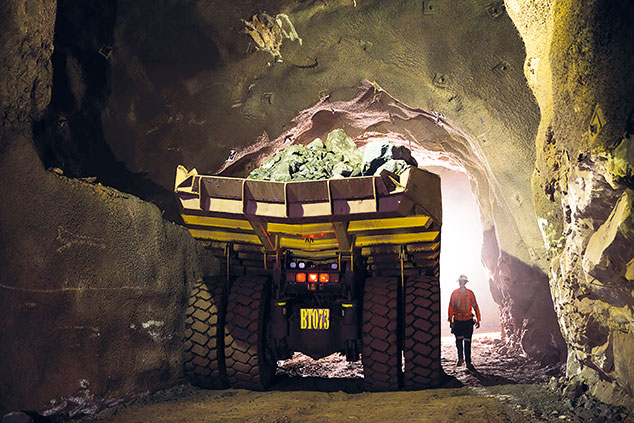
The BlackRock World Mining Trust has been on a roller-coaster ride, but is recovering well.
Barely ten years ago the FTSE 100 index included 12 mining companies, none of which operated a single mine in the UK. That number is now down to five but, after a near-death experience a few years back, the sector is in rude health, generating strong cash-flow and raising dividends.
This roller-coaster ride has been mirrored by the £670m BlackRock World Mining Trust (LSE: BRWM), which, after five years of negative performance, returned 100% in 2016 and 24% in 2017. The net asset value (NAV, the value of the underlying portfolio) has more than doubled since the end of 2015, but is still less than half of what it was at the end of 2010. “It’s still early in the sector’s cyclical recovery,” says Evy Hambro, co-manager, “with mining equities pricing in commodity prices well below current spot prices, and investors as underweight as [they were] at the sector low.”
Miners have learned lessons
A few years ago, things looked very different. Prior to 2011, surging demand from China had driven metal prices sky-high. Mining companies had committed themselves to significant new projects and embarked on major acquisitions. But when demand growth tailed off and new supply came through, metal prices fell sharply. Falling cash flow made debts unaffordable, projects were abandoned and dividends cut.
BRWM’s attempt to diversify by investing in royalty streams backfired when London Mining went bankrupt in 2014, wiping 10% off the value of the fund’s assets. The share price, which had already fallen with the broader sector, plunged further, and confidence in the trust tumbled.
However, the fund has seen a notable recovery. Metal prices have bounced and, with them, the cash flow and profits of the surviving miners. With new projects abandoned and company managements learning their lessons about capital discipline, supply is constrained while demand is firm.
Global inventories have fallen, underpinning prices. The sources of demand are changing, but metal demand continues to grow, though at a slower rate than the global economy. However, the growth of the electric-car business is expected to boost demand for lithium, cobalt and rare earth metals greatly.
Investors’ scepticism is based on doubts about the sustainability of growth in China, a distrust of mining management and low confidence that margins will be maintained. Yet growth in China remains above 6% per year and, in order to reduce pollution, it is cutting back on domestic supply. Global mining companies have cut capital expenditure by 45% and abandoned ambitions for growth, while continuing to raise productivity.
Risky buys have paid off
The team’s increasing confidence is reflected in the fact that it has added to its investments in the riskier companies and has borrowed up to 15% of its NAV for investment purposes. This offsets the 11% of NAV invested in corporate debt yielding 7%-8%. A $12m investment five years ago in a royalty on Avanco’s Antas mine in Brazil has paid off, doubling in value to 2.3% of the fund, and paying back $6m.
The success has prompted OZ Minerals to bid for the company, providing an extra benefit to the trust through its shareholding, accounting for 2.4% of NAV. Finally, few investors would have had the courage to buy Vale, the Brazilian iron-ore miner, at its low in early 2016. This now accounts for 8% of NAV, having risen by 70% last year.
The fund’s returns were 3% ahead of the Global Mining index last year, despite the dull performance of the 13% of the fund invested in gold mining and 8% in silver and diamond mines. Invest now, but be prepared to take profits when euphoria returns.
Activist watch
ThyssenKrupp AG’s chief Heinrich Hiesinger is “facing the fight of his career” as two activist investors take aim at the German industrial giant, says Bloomberg. Activist fund Elliott Management, which is building a stake in the company, wants to oust the 57-year-old CEO for failing to guide the company through a turnaround.
ThyssenKrupp has faced falling revenue and rising costs, and has been criticised by shareholders, including Swedish fund Cevian Capital, for its complicated structure, which spans submarines, lifts and food packaging. Another major gripe is a proposal to merge the European steel business with Tata, a key part of Hiesinger’s turnaround plan. Shares in the company rose by nearly 10% on the news of Elliott’s purchase.
Short positions… more woe for Woodford
• Wealth manager Charles Stanley has taken Neil Woodford’s Equity Income Fund off its list of “high-conviction” investment ideas, says Lucy White in City AM. The fund had been on the list since 2015, but the group had started to “harbour some concerns” that overall performance from the equity income fund may become increasingly affected by a “relatively small number of existing high-growth and earlier-stage businesses in the portfolio”. The move comes just a month after Woodford’s fund was shunted out of the Investment Association’s equity income sector for failing to yield enough in comparison with the FTSE All-Share index.
• Legal & General Investment Management has developed a proprietary index that will form the basis of its first gender-oriented fund, says Natalie Kenway in Investment Week. The index will score and rank the top 350 UK-listed companies based on four gender diversity measures, with companies expected to reach a minimum of 30% representation of women in each measure. The L&G Future World Gender in Leadership (Girl) UK index fund will charge an annual fee of 0.5%.
• Asset manager Janus Henderson plans to close its UK Strategic Income unit trust due to concerns that its assets under management of just £10.8m no longer make it viable, says Mike Sheen in Investment Week. Investors must decide whether to switch to another fund or trust, redeem their shares prior to the closure date, or do nothing and receive pro-rata proceeds from the liquidation.